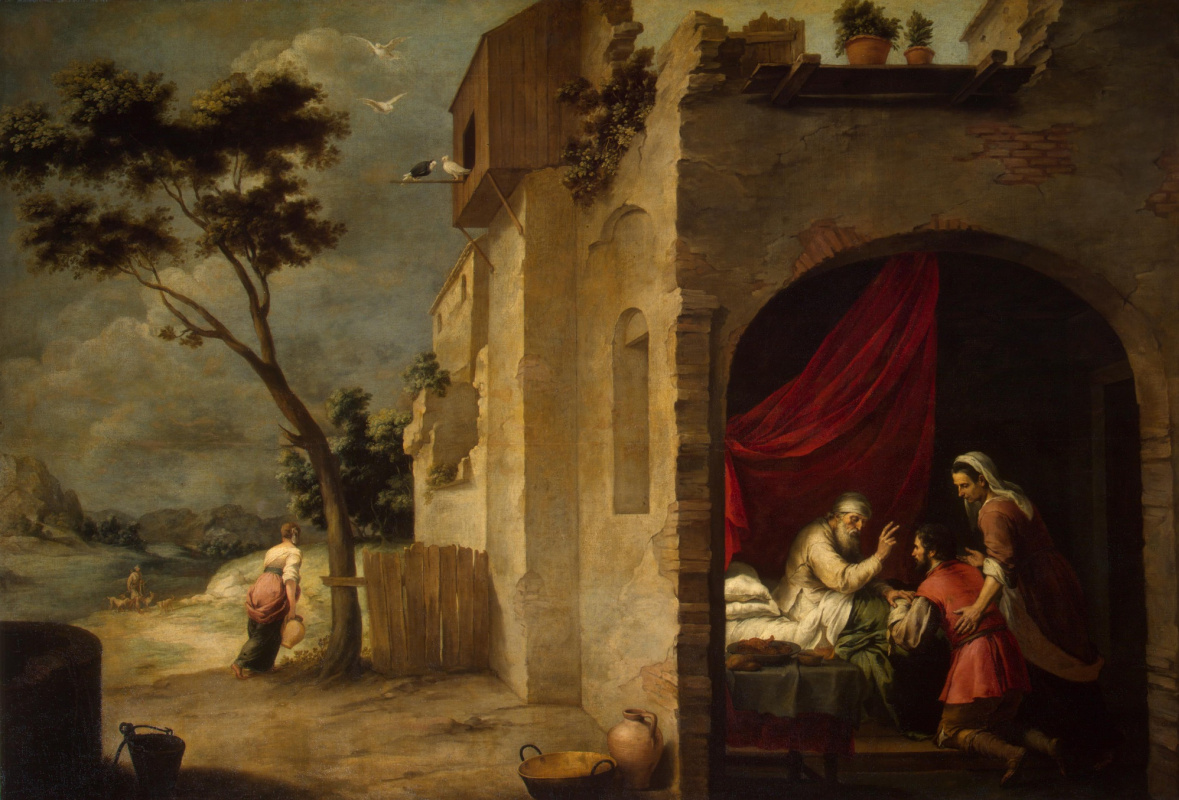log in
Enter site
Login to use Arthive functionality to the maximum
The Isaac Blessing Jacob
Bartolomé Esteban Murillo • Painting, 1660-th
, 245×357 cm
Description of the artwork «The Isaac Blessing Jacob»
The Marquis de Ayamonte and Villamanrique, influential patron organized by Bartolome Esteban Murillo of the Academy of arts, 1660-ies he ordered a cycle of paintings from the life of the biblical Jacob. I wonder their purpose: the paintings were to decorate the Palace of the Marquis, not from within but from outside (as was sometimes done in Italy but to Spain, such a way was exotic). There are several explanations for what reasons the Marquis decided to hang pictures exactly. First, it worked as is his brainchild Academy. Second, since the Spanish Reconquista in the minds of the entrenched belief that any successes are in direct proportion to the level of Catholic piety. Biblical subjects could "tell heaven", the master of the house worthy of his head was revealed to the well-being.
All pictures were five. Two of them are now in America ("Jacob with the flock of Laban" Museum of Spanish painting in fresh meadows, Texas; "Laban searches for the stolen idols" Museum of art, Cleveland), the other two – in Russia ("Jacob's Ladder", "Isaac Blessing Jacob" The Hermitage, Saint Petersburg). The fifth painting, "the Meeting of Jacob and Rachel", is considered lost.
The basis of the Hermitage "Blessings of Jacob" is the story from Genesis about how before his death, Isaac had intended to bless his eldest son Esau to give him the role of head of the family. However, Rebekah is abusing the blindness of a dying husband. It brings the blessing of Jacob, the younger son and their pet.
In earlier paintings of scenes from the New Testament Murillo developed his own method of connection of the biblical characters with modern domestic realities. The same method used in the reference to the old Testament. Vessels in the foreground, dovecote and flower pots on the roof, the old wooden fence and crumbling plaster revealing the brickwork – all of it borrowed from the simple life of these Andalusians, contemporaries of Murillo.
Interestingly, "Isaac Blessing Jacob" – a rare, almost exceptional case of the use of landscape in the works of Murillo. The artist almost did not write landscapes. Even immensely loved Seville are not reflected in the works of Murillo, in contrast to, for example, from the same El Greco, depicting architectural and landscape the appearance of the native Toledo.
In the "Blessing of Jacob" the scenery is lovely and very finely executed in the Flemish spirit, but Autonomous from the main stage. The end of the house divides the picture into three parts, each of which could become a full-fledged independent work in different genres. Right – the ominous landscape, in the center – still life with basket and pitcher against the wall and finally on the right, genre or historical composition, which gave the picture a name.
Author: Anna Yesterday
All pictures were five. Two of them are now in America ("Jacob with the flock of Laban" Museum of Spanish painting in fresh meadows, Texas; "Laban searches for the stolen idols" Museum of art, Cleveland), the other two – in Russia ("Jacob's Ladder", "Isaac Blessing Jacob" The Hermitage, Saint Petersburg). The fifth painting, "the Meeting of Jacob and Rachel", is considered lost.
The basis of the Hermitage "Blessings of Jacob" is the story from Genesis about how before his death, Isaac had intended to bless his eldest son Esau to give him the role of head of the family. However, Rebekah is abusing the blindness of a dying husband. It brings the blessing of Jacob, the younger son and their pet.
In earlier paintings of scenes from the New Testament Murillo developed his own method of connection of the biblical characters with modern domestic realities. The same method used in the reference to the old Testament. Vessels in the foreground, dovecote and flower pots on the roof, the old wooden fence and crumbling plaster revealing the brickwork – all of it borrowed from the simple life of these Andalusians, contemporaries of Murillo.
Interestingly, "Isaac Blessing Jacob" – a rare, almost exceptional case of the use of landscape in the works of Murillo. The artist almost did not write landscapes. Even immensely loved Seville are not reflected in the works of Murillo, in contrast to, for example, from the same El Greco, depicting architectural and landscape the appearance of the native Toledo.
In the "Blessing of Jacob" the scenery is lovely and very finely executed in the Flemish spirit, but Autonomous from the main stage. The end of the house divides the picture into three parts, each of which could become a full-fledged independent work in different genres. Right – the ominous landscape, in the center – still life with basket and pitcher against the wall and finally on the right, genre or historical composition, which gave the picture a name.
Author: Anna Yesterday


